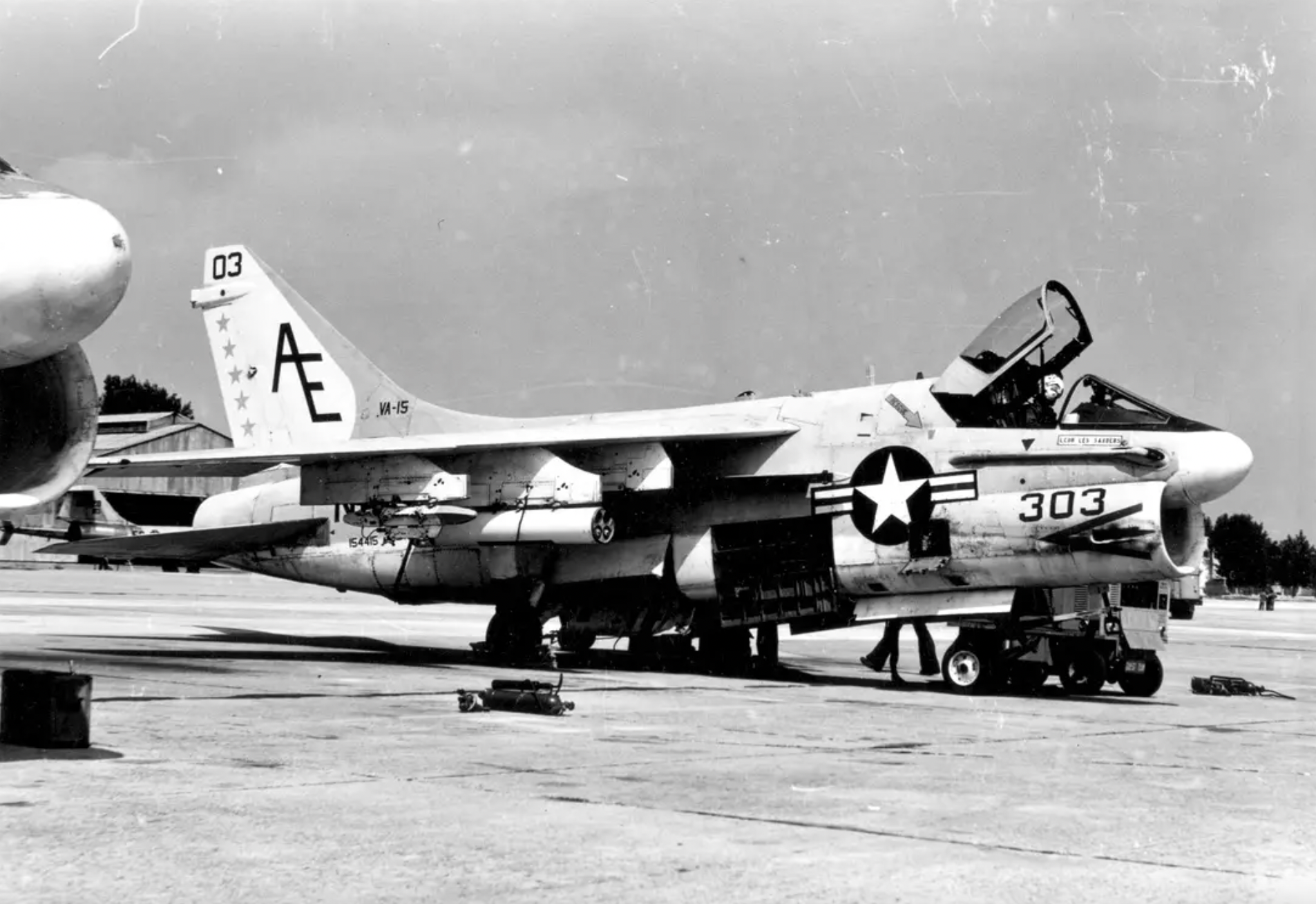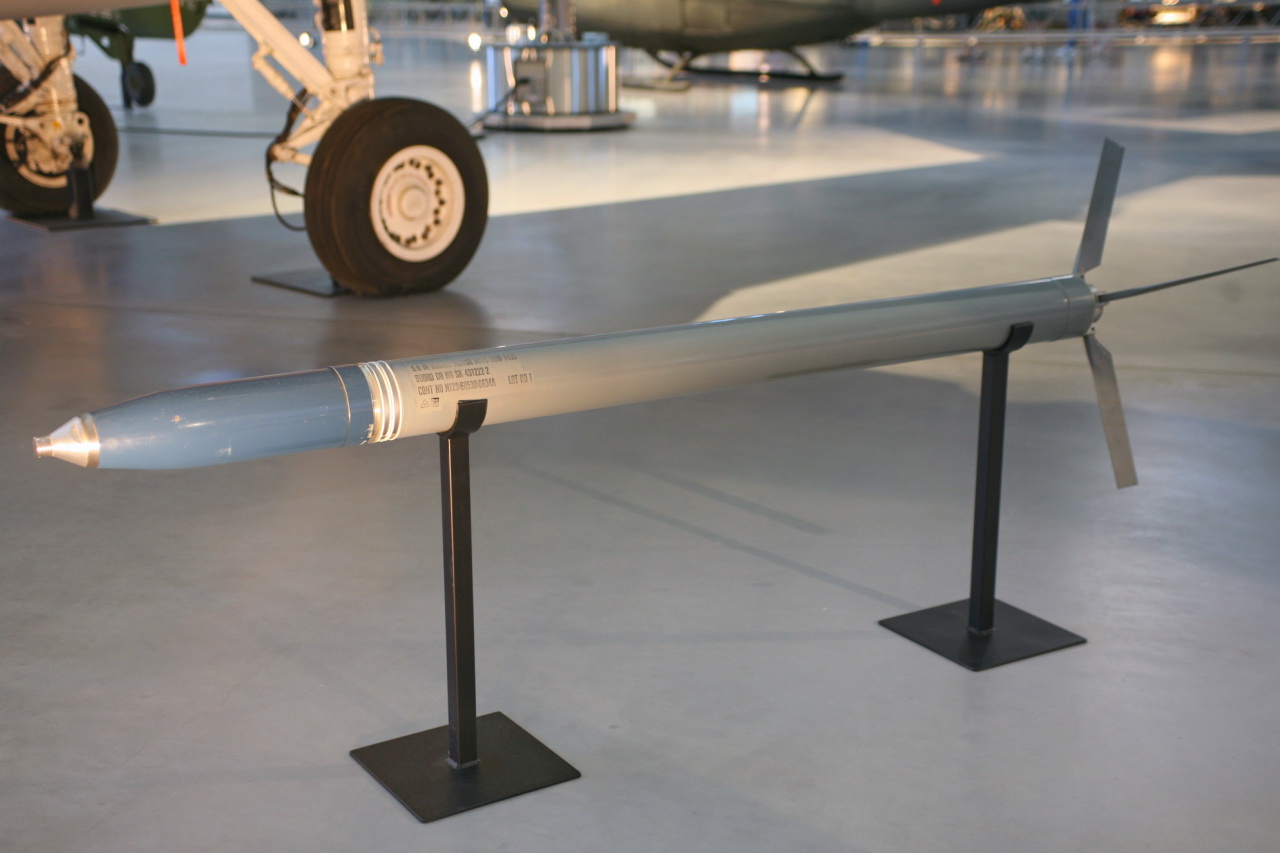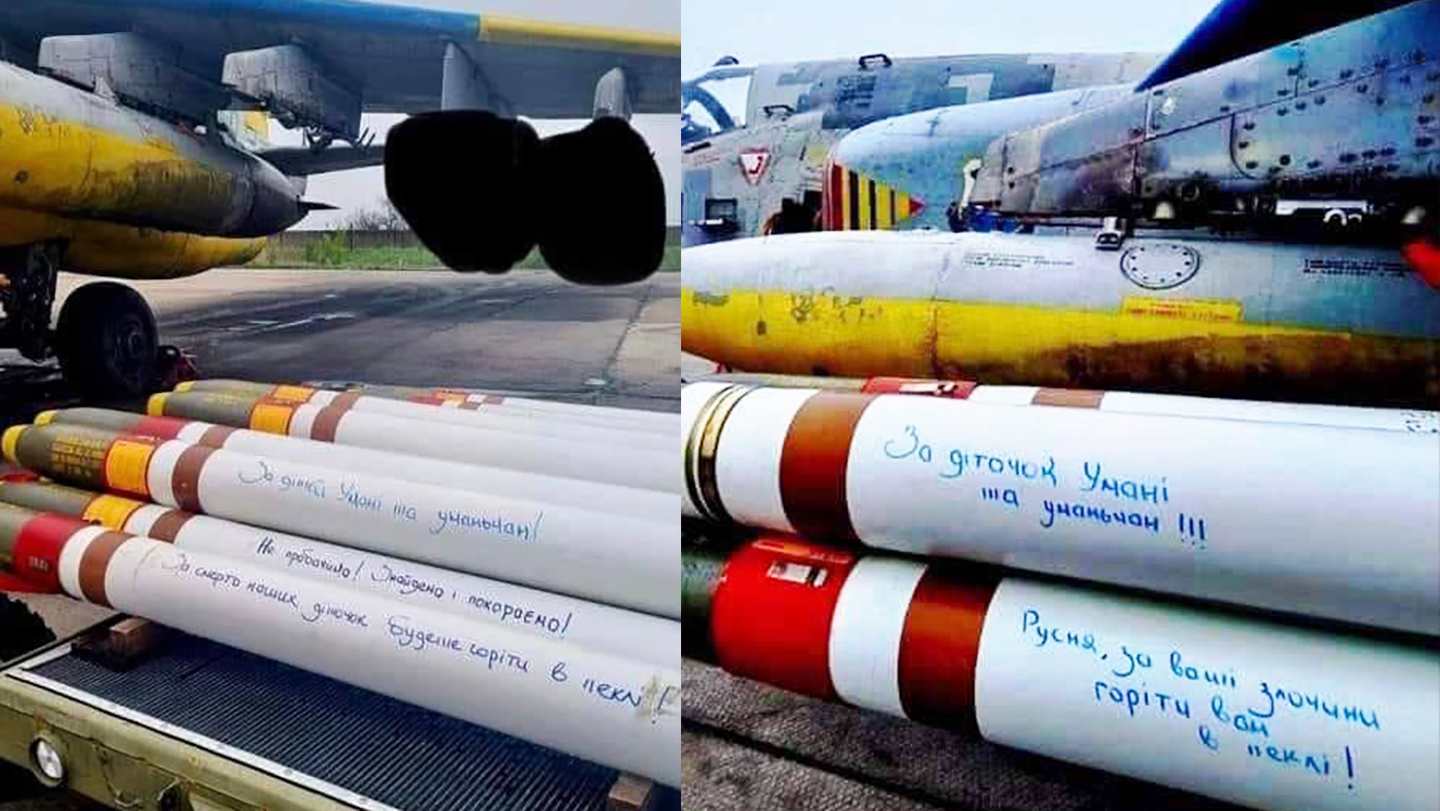At least some of the 5-inch Zuni air-launched rockets pledged to Ukraine by the United States have now been delivered, according to new photos. The unguided rockets appear to be in use with the Ukrainian Air Force’s Su-25 Frogfoot attack aircraft, which have so far been extensively used for attacks on Russian positions using Soviet-era rockets, supplies of which are apparently now running low.
The photos in question began to circulate on social media today and show a weapons cart loaded with live Zuni rockets, in front of a Ukrainian Air Force Su-25 in distinctive ‘digital’ camouflage as well as blue and yellow identification panels.
The rockets nearest to the camera have had morale-boosting Ukrainian-language slogans applied, something we have seen on other air-launched weapons in the past. In this case, one rocket carries the words “This is the answer for the kids in Uman’ and all Uman’ people,” while the other reads “Rusnya, burn in hell for your crimes!” The first slogan almost certainly relates to the Russian airstrike on an apartment block in the city of Uman‘ last Friday, which killed at least 23 people, suggesting the photo is very recent.
Interestingly, two stores under the aircraft’s wing have been censored, obscuring the type of rocket pods used, as well as how many of the Zunis each Su-25 might typically be loaded with. It also means that we don’t yet know how the launcher was integrated with the aircraft (the pylon adapter is also hidden), although rocket pods are fairly simple overall, so it may have been a relatively easy adaptation.

The transfer of 4,000 Zuni rockets to Ukraine was first confirmed back in January, as part of a $3-billion Pentagon aid package that was headlined by 50 M2 Bradley infantry fighting vehicles, which have also now started to arrive in Ukraine. You can read more about that particular arms package in our original report here.
The Zuni itself is essentially a sort of a ‘system’ consisting of a standardized rocket motor/main section onto which different warheads can be attached. While the importance of the basic Zuni rocket in the U.S. inventory gradually diminished following the arrival of more precision-guided ordnance (including laser-guided rockets), ending in its final withdrawal, the history of this weapon is long and its combat record is impressive.
The U.S. military began using 5-inch rockets to arm tactical aircraft back in World War II, with the first air-launched weapon of this caliber being a development of an earlier 3.5-inch air-launched anti-submarine rocket used by the U.S. Navy. The 5-inch Forward-Firing Aircraft Rocket, or FFAR, combined the motor from this anti-submarine weapon with the warhead from an anti-aircraft shell, producing the 5-inch FFAR. This entered service in late 1943.

The 5-inch High-Velocity Aircraft Rocket, or HVAR, was an improved weapon, with a larger motor ensuring greater speed and destructive power and it also saw use in World War II.
These weapons served as the progenitors of the Zuni, developed by the U.S. Navy in the early 1950s. The major change was the introduction of folding fins, which meant that multiple examples could be carried in more streamlined external pods. With this, the designation of the weapon was amended to Folding-Fin Aircraft Rocket, also FFAR.

The modular nature of the Zuni FFAR means that many different warhead types, fuzes, and motors have been fielded since the weapon entered service in the second half of the 1950s. Broadly speaking, however, an individual Zuni rocket is roughly 110 inches long and weighs a little over 100 pounds.
During the U.S. war in Vietnam, the Zuni became something of a signature weapon, arming a wide range of U.S. Navy and Marine Corps aircraft but also gaining notoriety for its role in the devastating fire aboard the aircraft carrier USS Forrestal in July 1967, when one of the rockets was inadvertently launched on the deck.

More recent versions of the Zuni include the Wrap-Around Fin Aerial Rocket, or WAFAR version, which uses a new nozzle/fin assembly together with a smokeless Mk 71 motor (very likely the type supplied to Ukraine). In its later use, the Zuni was mainly fired from four-round pods in the LAU-10 series, although it’s unclear at this point what types of launchers have been provided to Ukraine.

With a large assortment of warhead types and fuzes available, it’s very likely that Ukraine has received different types which can then be employed against various targets (armored vehicles, troops, etc.) as required. Illumination and smoke warheads are other options, for targeting.
Accounts of Ukrainian Air Force Su-25 operations in the conflict so far, supported by numerous photos and videos that have become available, show that these attack aircraft are using unguided rockets on a significant scale. Indeed, evidence of these jets using freefall bombs or air-to-ground missiles is extremely scarce in comparison.
Until now, the Ukrainian Su-25s have been using three primary types of Soviet-era aircraft rockets, all of which are unguided, and which were developed in the 1970s. These are the 80-millimeter (3.15-inch) caliber S-8, the 122-millimeter (4.80-inch) S-13, and the 266-millimeter (10.50-inch) S-25. Only the first of these is launched from a pod, with each B-8 launcher carrying up to 20 rockets.
The larger and more powerful S-13 (as seen in the video embedded below) and S-25 rockets are carried individually and are suitable for attacking larger and more hardened targets.
As such, the Zuni is likely intended to supplement the S-8 and S-13 rockets, stocks of which are also being used up through extensive use by Ukrainian Army Aviation helicopters, chiefly the Mi-24 Hind and Mi-8 Hip series of rotorcraft.
Compared to the S-8 and S-13, the Zuni also offers a greater range. When fitted with an anti-armor/fragmentation warhead, for example, the S-8 has a range of around 2.5 miles, while other rockets in the series, depending on warhead type, don’t even reach this distance. An S-13 with a penetrating warhead also has a range of 2.5 miles. The Zuni, by contrast, has a typical range of around 5 miles.

This range advantage may also lead to changes in the way that Ukrainian Su-25s employ their rockets. In the conflict so far, both Ukrainian and Russian fixed-wing attack aircraft and helicopters have often fired unguided rockets in a pop-up maneuver. This involves approaching the target at a very low level and then lobbing the weapons toward the objective, with the aim of minimizing exposure to hostile ground-based air defenses. Using tactical airpower as ‘airborne multiple rocket launchers’ may be critical for survival, but the effectiveness achieved is questionable, at best, other than against unprotected area targets.
Ukrainian Su-25s launch rockets using a typical attack profile:
The additional range offered by the Zuni should allow targets to be engaged more accurately from a greater distance, putting the launch aircraft outside the range of many very short-range air defense systems (VSHORADS) including man-portable air defense systems (MANPADS).
This is potentially even more significant for Ukraine’s slower-flying and more vulnerable rocket-armed helicopters. Although we don’t know yet whether these have received Zunis, integration of these unguided weapons also shouldn’t pose a significant problem. It’s notable that, so far, we have seen very little evidence of Ukrainian helicopters using anti-tank guided missiles, which would be able to hit targets accurately from longer ranges, meaning they are very much reliant on unguided rockets that expose them to much greater danger. A rocket with roughly twice the range of the current S-8 and S-13 would clearly be a big deal in this context.
A Ukrainian Mi-24 employs S-8 rockets in a pop-up maneuver:
With 4,000 Zuni rockets headed to Ukraine, this represents a significant boost to the country’s aircraft rocket stocks. It may also speak to the fact that Ukraine is using up stocks of Soviet-era weapons that cannot be readily sourced in large numbers anywhere else, at least outside of Russia.
There’s also the possibility that we might see Ukraine adapting Zunis for ground launch, something that it has done in the past with its S-8 rockets, in particular. On the other hand, it’s easy to imagine that the advance in capability that the Zuni brings will see it earmarked for exclusive use by the Ukrainian Air Force and Army Aviation.
Despite its age, the Zuni remains a very useful weapon, especially for an air force that is now well-versed in using unguided rockets as one of its primary means of battlefield assault. There remains the possibility that Ukraine might even get its hands on a guided version of the Zuni, although there is no evidence of that so far.
A laser-guided conversion of the Zuni was at least demonstrated to the U.S. Marine Corps and Navy in the late 2000s and may also have been tested in some capacity on the OV-10 Bronco turboprop attack aircraft that were later used in Iraq by the U.S. Special Operations Command. A laser-guided Zuni would require either an operator on the ground with a laser designator, to illuminate the target, or integration with the fire-control system of the launch aircraft — the Su-25 incorporates an internal laser rangefinder/target designator. While self-designating would make the launch aircraft vulnerable to ground-based air defenses, laser designation by troops on the ground would not require the Su-25 to engage at higher altitude, making attacks of this kind more survivable.
This would not necessarily be a quick or straightforward modification but could be of interest in the longer term and, with the U.S.-supplied AGM-88 High-speed Anti-Radiation Missile, or HARM, and the Joint Direct Attack Munition-Extended Range, or JDAM-ER, more complex weapons integrations have been achieved by Ukraine in the past.
As its stands, even a fairly antiquated unguided rocket is still useful for Ukraine, particularly against known Russian positions, something that would be of considerable importance as part of any upcoming offensive. In this way, volleys of air-launched rockets would likely be a very useful adjunct to conventional artillery. At the same time, this is yet another example of weapon improvisation on the Ukrainian battlefield, something we are likely to see more of as weapons stocks, more generally, run low.
We will watch further developments with interest, especially to see if and how the arrival of this enduring weapon changes the way that Ukraine conducts airstrikes, whether by Su-25 attack jet, or other aircraft.
Special thanks to Ilona Bulankova for her assistance in preparing this story.
Contact the author: thomas@thedrive.com
